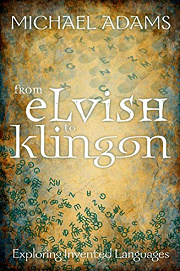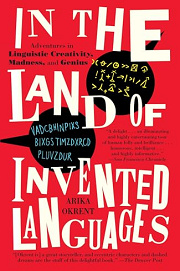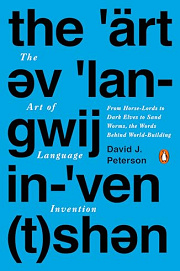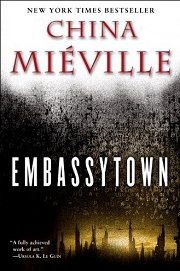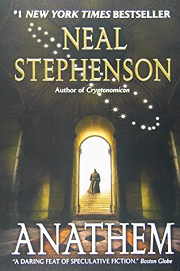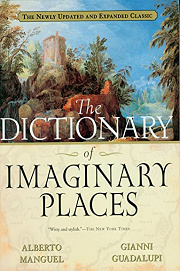Share your thoughts in a quick Shelf Talk!
From Elvish to Klingon: Exploring Invented Languages by Michael Adams
From Elvish ballads to Klingon battle cries, discover how invented tongues shape the worlds we love. Linguists and fans alike will find ingenuity, culture, and play woven into every phoneme. From Elvish to Klingon: Exploring Invented Languages is a fascinating tour of how language makes fiction feel real.
Have you read this book? Share what you liked (or didn’t), and we’ll use your answers to recommend your next favorite read!
Love From Elvish to Klingon: Exploring Invented Languages but not sure what to read next?
These picks are popular with readers who enjoyed this book. Complete a quick Shelf Talk to get recommendations made just for you! Warning: possible spoilers for From Elvish to Klingon: Exploring Invented Languages below.
In From Elvish to Klingon: Exploring Invented Languages, did you enjoy ...
... the rigorous, witty history-and-culture tour of conlangs from Tolkien’s Elvish to Okrand’s Klingon and beyond?
In the Land of Invented Languages by Arika Okrent
You loved how Adams’s collection moved from Tolkien’s Quenya and Sindarin to Marc Okrand’s Klingon, pausing to consider Esperanto’s utopian aims and even blockbuster tongues like Na’vi. Okrent gives you that same breadth with a sharper historical throughline—tracing why Klingon’s aggressive phonology caught on with fans, how Esperanto’s ideals shaped its community, and what Tolkien meant by “a mythology for England.” If you enjoyed toggling between linguistic nuts-and-bolts and cultural stories in From Elvish to Klingon, you’ll relish this equally brainy, highly readable deep dive.
... the nuts-and-bolts worldbuilding of sound systems, morphology, and culture-driven vocabulary you saw in the Elvish and Klingon chapters?
The Art of Language Invention by David J. Peterson
Adams’s book shows how languages like Sindarin mirror Elvish culture and how Klingon’s harsh consonants project a warrior ethos. Peterson takes you behind the curtain to build those systems yourself—designing phonologies, crafting case systems, and shaping idioms from culture outward (just as Tolkien did with Quenya’s aesthetics and Okrand did with Klingon’s clipped imperatives). If the careful scaffolding behind those languages fascinated you, this hands-on guide will scratch exactly that itch.
... the big-idea exploration of how language shapes thought and society, like the essays comparing Elvish aesthetics, Klingon honor culture, and Esperanto’s ideals?
Embassytown by China Miéville
Where Adams’s essays link form to culture—Elvish beauty, Klingon martial values, Esperanto’s politics—Miéville builds a haunting first-contact tale around it. The Ariekei can only speak truth; their Language has no lies until humans introduce metaphor, with consequences as seismic as inventing a new grammatical mood. If the book’s discussions of Klingon’s social signaling or Tolkien’s philological worldbuilding intrigued you, Embassytown turns those questions into a gripping, idea-rich story.
... the sense of wonder at fully realized cultures with bespoke lexicons, akin to the deep dives on Quenya/Sindarin lore and Klingon usage?
Anathem by Neal Stephenson
Adams highlights how vocabulary encodes worldview—Tolkien’s Elvish for beauty and history, Klingon for honor and conflict. Anathem immerses you in a cloistered scholar culture whose specialized terms (from “saunt” to “anamnesis”) work like a constructed language, unlocking a civilization’s mindset as the plot scales from monastery debates to cosmic stakes. If you enjoyed how the book tied lexicon to culture (and even touched on Na’vi’s community uptake), this will deliver that awe on an epic canvas.
... the browseable, chapter-to-chapter tour of fictional worlds and their cultural details, like hopping from Elvish philology to Klingon linguistics to Esperanto history?
The Dictionary of Imaginary Places by Alberto Manguel and Gianni Guadalupi
One delight in Adams’s volume is flipping from Tolkien’s etymologies to Klingon’s guttural phonemes and the social story of Esperanto. This encyclopedic guide offers that same pleasure of discovery in short, witty entries—walking you through the cultures, customs, and occasionally the languages of places from Middle-earth to more obscure realms. If you enjoyed sampling focused case studies in From Elvish to Klingon, this is a perfect companion for dipping in and out.
Unlock your personalized book recommendations! Just take a quick Shelf Talk for From Elvish to Klingon: Exploring Invented Languages by Michael Adams. It’s only a few questions and takes less than a minute.
